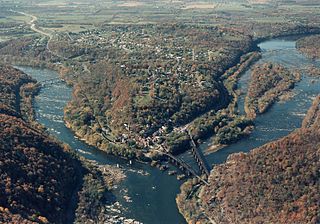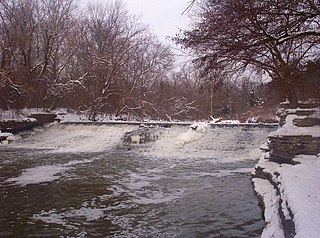| Big Sandy Creek | |
|---|---|
| Physical characteristics | |
| Main source | Morgan County southeast of Jacksonville, Illinois 39°37′54″N90°10′16″W / 39.6317141°N 90.1712282°W |
| River mouth | Confluence with the Illinois River, Scott County, Illinois 423 ft (129 m) 39°33′04″N90°34′23″W / 39.5511587°N 90.5731814°W Coordinates: 39°33′04″N90°34′23″W / 39.5511587°N 90.5731814°W |
| Basin features | |
| GNIS ID | 417992 |
| Little Sandy Creek | |
|---|---|
| Physical characteristics | |
| Main source | Scott County west of Manchester, Illinois 39°32′04″N90°20′32″W / 39.5344914°N 90.3423437°W |
| River mouth | Confluence with Big Sandy Creek approx. 1/3 mile above the Illinois River 423 ft (129 m) 39°33′07″N90°34′01″W / 39.5519919°N 90.5670701°W |
| Basin features | |
| GNIS ID | 412409 |
Big Sandy Creek, often called the Big Branch, is a tributary of the Illinois River in central Illinois. It drains a large portion of southwestern Morgan County and southern Scott County. The drainage of Big Sandy Creek includes Lake Jacksonville and the county seat of Scott County, Winchester, Illinois. [1]

A tributary or affluent is a stream or river that flows into a larger stream or main stem river or a lake. A tributary does not flow directly into a sea or ocean. Tributaries and the main stem river drain the surrounding drainage basin of its surface water and groundwater, leading the water out into an ocean.

The Illinois River is a principal tributary of the Mississippi River, approximately 273 miles (439 km) long, in the U.S. state of Illinois. The river drains a large section of central Illinois, with a drainage basin of 28,756.6 square miles (74,479 km2). The drainage basin extends into Wisconsin, Indiana, and a very small area of southwestern Michigan. This river was important among Native Americans and early French traders as the principal water route connecting the Great Lakes with the Mississippi. The French colonial settlements along the rivers formed the heart of the area known as the Illinois Country. After the construction of the Illinois and Michigan Canal and the Hennepin Canal in the 19th century, the role of the river as link between Lake Michigan and the Mississippi was extended into the era of modern industrial shipping. It now forms the basis for the Illinois Waterway.

Morgan County is a county located in the U.S. state of Illinois. According to the 2010 census, it had a population of 35,547. Its county seat is Jacksonville.
Most of the Big Sandy Creek drainage is intensely farmed arable land. Because the land is sandy, nitrogen runoff due to fertilizer application is significant. In addition, Jacksonville and Winchester drain their sewage into the creek. [1]

Eutrophication, or hypertrophication, is when a body of water becomes overly enriched with minerals and nutrients which induce excessive growth of plants and algae. This process may result in oxygen depletion of the water body. One example is an "algal bloom" or great increase of phytoplankton in a water body as a response to increased levels of nutrients. Eutrophication is often induced by the discharge of nitrate or phosphate-containing detergents, fertilizers, or sewage into an aquatic system.

Jacksonville is a city in Morgan County, Illinois, United States. The population was 19,446 at the 2010 census. It is the county seat of Morgan County. It is home to Illinois College, MacMurray College, Illinois School for the Deaf, and the Illinois School for the Visually Impaired.

Sewage is a type of wastewater that is produced by a community of people. It is characterized by volume or rate of flow, physical condition, chemical and toxic constituents, and its bacteriologic status. It consists mostly of greywater, blackwater ; soaps and detergents; and toilet paper.
Little Sandy Creek is a tributary of Big Sandy Creek. The two streams combine shortly before discharging into the Illinois River opposite the hamlet of Montezuma, Illinois. Sand discharged by the alluvial creeks may have helped form McEvers Island, a silt island in the Illinois River just below the mouth of the creek.

Montezuma Township is located in Pike County, Illinois. As of the 2010 census, its population was 540 and it contained 254 housing units.
McEvers Island is an uninhabited fluvial island in the Illinois River. Approximately 1 mile (1.6 km) long, it is legally part of Montezuma Township within Pike County in the U.S. state of Illinois. The island, at Mile 48.5, is often used as a landmark by commercial and pleasure boaters traversing the river. Boaters often anchor or tie up in the narrow, sheltered channel east of the island, bordering the Scott County Illinois mainland.










